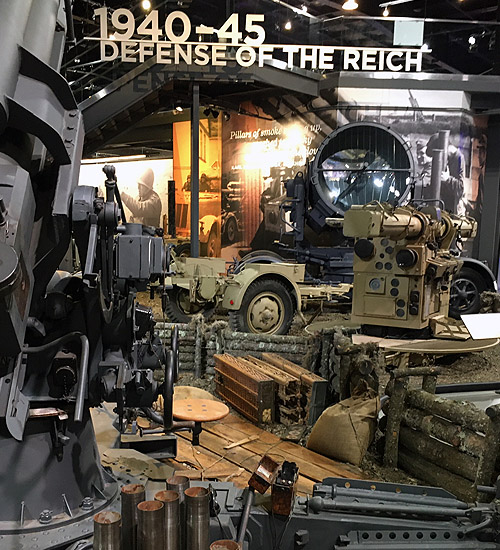Defense of the Reich

8.8 cm Flak 36 – GER | ANTI-AIRCRAFT GUN
Sd.Kfz. 8 12 TON – GER | PERSONNEL CARRIER/PRIME MOVER
Kommandogerrat 38 – GER | FIRE CONTROL COMPUTER
Flak Battery Generator – GER | ANTI-AIRCRAFT BATTERY SUPPORT
Flak Battery Searchlight – GER | ANTI-AIRCRAFT BATTERY SUPPORT
V-1 (“JB-2 Loon” – Suspended) – GER | GUIDED MISSILE
The Defense of the Reich (also known in German as Reichsverteidigung) was the name given to the strategic defensive aerial campaign fought by the Luftwaffe air arm of the combined Wehrmacht armed forces of Nazi Germany over German-occupied Europe and Nazi Germany during World War II. Its aim was to prevent the destruction of German civilians, military, and civil industries by the Western Allied bombing campaigns. The day and night air battles over Germany during the war involved thousands of aircraft and aerial engagements to counter the Allied strategic bombing campaign. The Luftwaffe fighter force defended the airspace over German-occupied territory against attack, first by RAF Bomber Command and then against the United States Army Air Forces.
The constant night bombing by the RAF and daylight attacks by the USAAF added to the destruction of a major part of the German’s industries and cities, which caused the economy to collapse in the winter of 1944–45. It also pulled nearly two million Germans into defense of the homeland and diverted critical, dual-purpose 88 mm guns from an anti-tank role in the east against the advancing Red Army to an antiaircraft role inside Germany itself. By this time, the Allied armies had reached the German border and the strategic campaign became fused with the tactical battles over the front, while also completing a deliberate and methodical Allied campaign of punishment of all of Germany by destruction of German cities and civilian morale. The air campaign continued until April 1945, when the last strategic bombing missions were flown, ending just before the surrender of Germany on May 8th.



